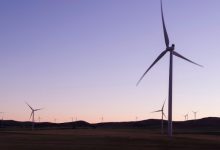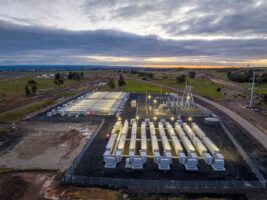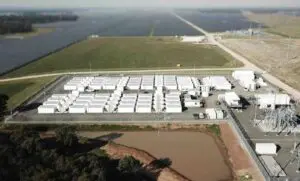Australia’s federal Coalition government was so dismissive of the Tesla big battery in South Australia that it compared it to the “Big Banana” and the Kardashians. “It’s just for show,” they sneered, and carried on thinking about ways to lend more support to the coal and gas sectors.
But in the 28 months that it has been in operation, the Tesla big battery (officially known as the Hornsdale Power Reserve) and the four batteries that have followed in its footsteps have changed the views of many about the role they can serve in the grid. There is no doubt that they have smoothed the transition path to a zero emissions grid.
Even the Coalition may finally have taken this on board. Batteries will, hopefully, now play a key role in the government’s “technology” pathway that has become its new mantra as it tries to navigate the politics, and dodge the policy commitments, of a zero emissions target by 2050.
As we report elsewhere, the Hornsdale battery has delivered huge cost saving to consumers by smashing a cartel once dominated by gas generators, and taking over a sizeable share of the critical FCAS markets by providing a faster, cheaper, cleaner and smarter service. It has saved consumers more than $150 million over the last two years just from these markets.
But it’s also its role in grid security that has changed the thinking about the role that batteries can play. The government-owned utility Snowy Hydro was so dismissive of Tesla batteries that it once claimed it would require 200 million of them to match the storage capacity of Snowy 2.0.
But what the Tesla big battery has shown over the last two years is the capability of doing things that Snowy 2.0 won’t be able to do.
And it has more tricks up its sleeve – so much so that the market operator and network owners are now looking to install batteries across the grid because of the multiple capabilities they bring in providing storage, but also keeping the lights on and allowing more renewables into the network.
They may even be used in place of traditional hardware to expand the capacity of existing transmission lines. See Big batteries eye unique opportunity to get inside running on grid upgrades
Soon after its commissioning, Tesla intervened rapidly to help arrest dangerous frequency changes when a major coal generator tripped. But that was just showing off, and just a taste of what was too come.
Three other instances highlight the critical role it plays in keeping the lights on, a role that is poorly understood. All involve sudden and dramatic events when the South Australia grid was separated from rest of the National Electricity Market because of a major transmission fault. And all three have been documented in a new report by Aurecon.
 The first one occurred in battery skeptic Scott Morrison’s first full day in the prime minister’s office, on August 25, 2018, when lightning strikes on the main link from NSW to Queensland set off a series of events that caused Queensland and South Australia to separate, and caused load shedding and generator failures in all states, except South Australia.
The first one occurred in battery skeptic Scott Morrison’s first full day in the prime minister’s office, on August 25, 2018, when lightning strikes on the main link from NSW to Queensland set off a series of events that caused Queensland and South Australia to separate, and caused load shedding and generator failures in all states, except South Australia.
As we wrote at the time: On first day as PM, Morrison learns difference between Big Battery and Big Banana
 Another event occurred on November 16 last year, when another fault caused South Australia to separate again. The Hornsdale battery played a key role in maintaining frequency, and then in providing the FCAS needed to support the South Australia grid. The report by Aurecon estimates that saved consumers $14 million in the five hours that the state was separated.
Another event occurred on November 16 last year, when another fault caused South Australia to separate again. The Hornsdale battery played a key role in maintaining frequency, and then in providing the FCAS needed to support the South Australia grid. The report by Aurecon estimates that saved consumers $14 million in the five hours that the state was separated.
See your story: South Australia’s renewables grid separates from NEM; lights don’t go out
 A third instance occurred on January 31, this year, when a major storm tore down the huge poles that support the 500kV wires that link Victoria and South Australia, and the state was islanded again, this time for more than two weeks.
A third instance occurred on January 31, this year, when a major storm tore down the huge poles that support the 500kV wires that link Victoria and South Australia, and the state was islanded again, this time for more than two weeks.
As AEMO said the state’s three big batteries played a critical role, along with wind and solar plants, in keeping the lights on at the time of separation, and for maintaining grid security for the following two weeks.
See our story: Wind and batteries saved the day when storm cut South Australia adrift
Now the Tesla big battery has another trick up its sleeve. It will be the first battery in Australia to supply inertia to the grid – up to half of South Australia’s needs – and adding much needed security to the local network.
The battery is often mocked because people say that it can only power the South Australia grid for a few seconds. But that only reveals the stupidity of the political and media commentary around energy in this country. It’s flat Earther talk.
In fact, no single generator can keep the lights on in South Australia for any time at all. The very idea is dumb. And the battery wasn’t designed to do that, or deliver significant amounts of storage capacity. But it has lowered costs, and kept the lights on, and given confidence in the technologies that will be needed in a grid dominated, or totally powered, by renewables.
Garth Heron, the development manager at Neoen Australia, which owns and operates the Hornsdale battery, says the new addition to the battery will be critically important for the evolution and the management of the grid.
“We’ve got a very complex network, and in order to try and reduce complexity a little bit, new generators connecting to the grid have been asked to simplify their response as much as possible,” Heron tells RenewEconomy.
“That had led to grid-following settings in inverters, and control systems that are fairly inert.” The reason for this, he says, is to avoid differing responses from different inverters because it could sow more confusion.
But with “grid forming” inverters, the new capability at Hornsdale, there is now the ability to address these issues, provide inertia to slow down there ate of change in frequency, and to provide system strength. Still, it needs to be carefully designed and managed because of the complexity of the system.
“The beautiful of this kind of inertia is that it can slow down ROCOF (rate of change of frequency) when you want to, but also speed up the response in recovery. It’s not like traditional inverter …. with this kind of inertia this is better than heavy spinning machines.”
Heron explains that it is not the batteries that are different: a lot of this capability comes from new control systems which are being added as part of the expansion of the Tesla big battery which is now mechanically complete and will conduct detailed testing in coming weeks.
“All of these things are part of a layered control system. The battery can do all of these things – not that we reserve different parts to do different things … we will set up batteries to do as much inertia as we can. So we have got more capacity to do everything., at same time expanding control system to do inertia for first time.”
Heron says that the success of Hornsdale has even surprised Tesla and Neoen. “We always new it would have a big impact. It has even surprised us – it has delivered market benefits well beyond anything we could have dreamed of.
“Hornsdale has just been the best asset for the state, and for us as well, it’s a real success story, something that we will see more of.
“It is just the tip of the iceberg that will enable these kind of savings in other states. It will make the grid so much more robust.”










